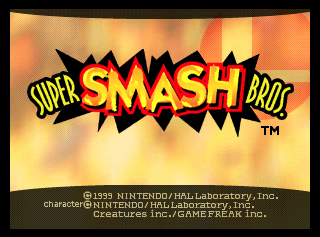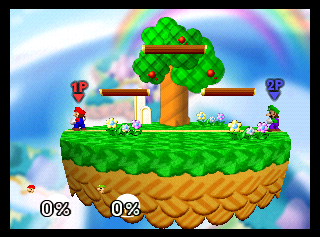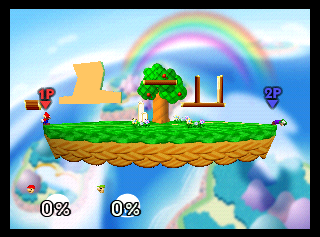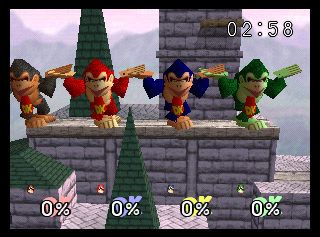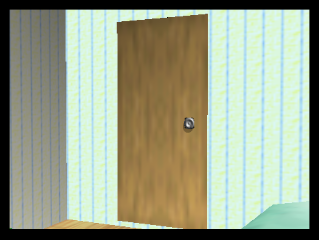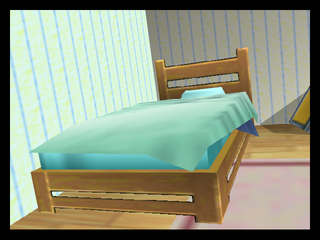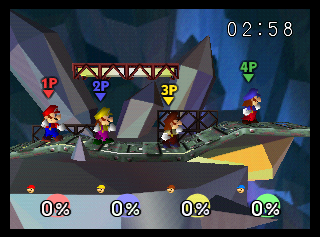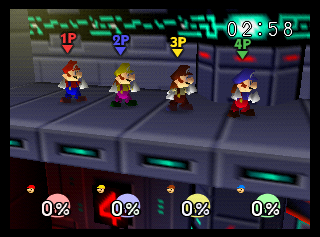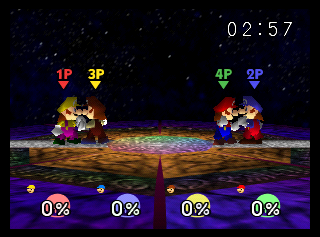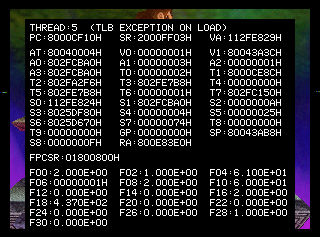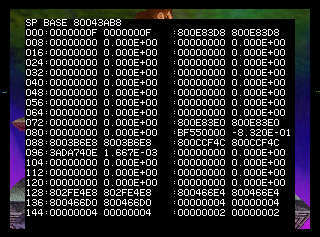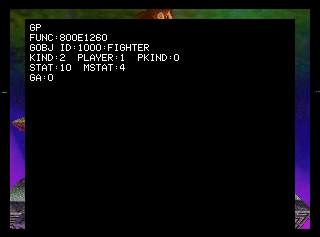Super Smash Bros.
| Super Smash Bros./fr |
|---|
|
Aussi connu comme: Nintendo All-Star! Dairantou Smash Brothers (JP)
|
| This article is a work in progress. ...Well, all the articles here are, in a way. But this one moreso, and the article may contain incomplete information and editor's notes. |
Super Smash Bros. est un jeu de combat crossover combinant des personnages de dix franchises Nintendo dans une soirée éclatante remplie de marteaux, de tornades, d'explosions, de Pokémon, de bâtons de baseball et d'un annonceur trop enthousiaste. Les résultats ont été… eh bien, la créativité et le plaisir devraient parler pour eux-mêmes.
Contents
Sous-pages
| Menus de débogage Il y a des choses vraiment intéressantes ici, mais pas plus que le celui de Super Smash Bros. Melee. |
| Différences régionales On dirait que Nintendo of America déteste Star Wars. |
Niveaux inutilisés
Deux niveaux inutilisés qui sont étonnament similaires à Dream Land, utilisant sa musique et son arrière-plan, qui étaient probablement utilisé pour tester le jeu.
Small
800A4D09 0009
New
800A4D09 000A
Comporte de cinq plateformes en bois, dont la plus petite bouge diagonalement en bas à gauche et en haut à droite, et deux qui bougent de gauche à droite au-dessus d'une autre plateforme; une plateforme de forme irrégulière; et une plateforme invisible au-dessus du niveau. Seule la plateforme principale et celle au-dessus du milieu du niveau ne sont pas solides quand elles sont interagies d'en dessous. Ce niveau contient les mêmes objets inutilisées et textures que "Small", et un des bancs de fleurs bouge de gauche à droite. Le joueur 3 apparaît dans la plateforme flottante devant l'arbre, le joueur 1 apparaît en dessous, le joueur 2 apparaît à droite du joueur 1 et le joueur 4 apparaît entre les plateformes de bois volantes. Comme le premier niveau de test, la plateforme volante qui apparaît après un KO apparaît au sol, au centre de la plateforme principale. Appelé "New" dans le menu de débogage de combat.
Graphiques Inutilisées
Costumes inutilisés
| To do: basé sur : this and this, il y a plusieurs costumes inutilisés et buggy pour Jigglypuff et Pikachu. De plus, il y avait évidemment une équipe / peau jaune à un moment donné pour au moins Pikachu et Rondoudou. Documentez-les correctement et voyez éventuellement s'il existe d'autres costumes comme celui-ci pour d'autres personnages. |
Giant Donkey Kong
L'utilisation du menu de débug de combat révèle que Donkey Kong Géant a quatre costumes alternatifs inutilisés qui sont identiques à ceux de Donkey Kong. Étant donné que Donkey Kong Géant est un personnage distinct de Donkey Kong, il est un peu inhabituel de voir cela, bien qu'ils ne soient probablement que le résultat de la copie par les développeurs de ses données.
Unseen Details
Hitbox Display
| Without hitboxes | With hitboxes |
|---|---|
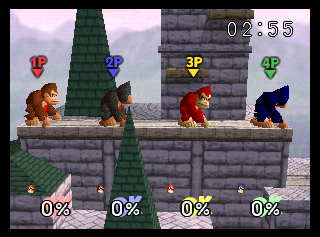 |
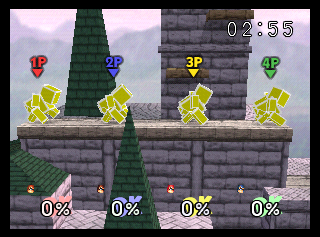 |
The GameShark codes below will display physical hitboxes for the characters. The characters become yellow cubes, showing the areas they can be hit by attacks, and when attacks are used, red and white cubes appear showing the area they hit if in contact with someone's hitbox. Sprites such as shields and Ness' PSI Magnet will still appear. Interestingly, there are several images on the Japanese Super Smash Bros. website that show these in use.
| Version | Gameshark code |
|---|---|
| USA | 810F2C04 2400 |
| Japan | 810F0824 2400 |
| Europe | 810FB854 2400 |
| Australia | 810F3414 2400 |
| iQue | 810F3764 2400 |
Hitboxes are not only shown during a match, but are also shown in the intro, character biographies in the Characters option in the Data menu, battle debug menu, "How to Play" video, and in the character selection screen; this will cause it to be glitched, however, as the characters appear in the center of the screen, and selecting more than one character will cause them to overlap each other. Projectiles' hitboxes will be absent, though using the code below will have them appear.
| Version | Gameshark code |
|---|---|
| USA | 81167578 2400 |
| Japan | 81164FD8 2400 |
| Europe | 811701B8 2400 |
| Australia | 81167D88 2400 |
| iQue | 811676D8 2400 |
There are also various colors for different hitbox functions:
| Color | Classification | Function |
|---|---|---|
| Red | Hitbox | Attacks, grabs. |
| Yellow | Hurtbox | Vulnerable. |
| Green | Hurtbox | Invincible (can get hit but takes no damage). |
| Blue | Hurtbox | Intangible (can't get hit). |
Regular items do not show hitboxes (including Link's Bomb), though projectiles used by Pokémon that emerge from the Poké Ball (including Beedrill) and those that emerge from the door in the Silph Co. building in Saffron City do, as well as the lasers from the Arwings in Sector Z.
Unused Player Spawn Locations
Unused 2P-4P spawn locations for stages that are only accessible in 1P Game. These stages can only be played through the battle debug menu or GameShark codes.
Metal Mario's Stage
The stage where Metal Mario is fought contains unused spawn locations for Player 1-4, suggesting that it may have originally been playable in VS Mode. Interestingly, these spawns are completely unused even in 1P Mode, as no one spawns on the floating platform like Metal Mario does, and P2's position is slightly to the left of where the player normally spawns in 1P Mode.
"Race to the Finish" Stage
The Race to the Finish bonus stage contains unused spawn locations for Player 2, Player 3, and Player 4.
Final Destination
The stage where Master Hand is fought has unused spawn positions for Player 3 and Player 4, 1 and 2 being used by the player and Master Hand respectively in 1P mode. Oddly, Player 3 and 4 spawn right in front of and face Player 1 and 2.
Unused Camera Angles
There are various unused camera angles in the data that can be re-enabled using Gameshark codes. To activate the angles, you must pause and unpause while in a match.
Angle 1
801314B7 0004
This angle brings the camera to roughly the center of the stage and makes it face the player when unpausing. If a player slams on the ground or falls off the stage, the camera will glitch out and look straight up until the player pauses again.
When used on a bonus stage, it will simply leave the camera locked in a full view of the stage. When used while fighting Master Hand, the camera will reset if he uses a move that sends him to the background. Pausing and unpausing will cause the camera to lock into a full view of the stage every time until Master Hand goes into the background again.
Angle 2
801314B7 0006
This angle changes the camera into a semi-bird's eye view, moving the camera up slightly and having it look down. The camera will attempt to keep every player in view at all times, meaning that it will zoom out far wider than normal.
Like angle 1, the camera will reset if Master Hand moves to the background. If it's reactivated while he's still in the background, however, it will somewhat follow his movements. This is most noticeable with his rocket move.
Unused Animations
All Fighting Polygon Team members, Giant Donkey Kong, and Metal Mario can enter the Warp Pipe in Mushroom Kingdom, but they can't normally do that since they never appear in this stage. Hence, they have unused animations for entering it, and exiting horizontally and vertically that are identical to those of the respective characters they are a "clone" of.
Unused Death
Each character has a death animation that is functional but completely unused. It could have been originally used for players getting eaten by Piranha Plants in Mushroom Kingdom or perhaps for at one point sinking into Planet Zebes' lava, but it's still unknown what it was supposed to be used for at this time.
Audio inutilisé
To do:
|
Victory Fanfare
Une fanfare courte. Elle peut être jouée dans le menu de débogage de système en tant que BGM n° 11.
Concept de Smash finaux
Selon le directeur du jeu, Masahiro Sakurai, les Smash finaux étaient destinés à être introduits depuis ce jeu, mais ce concept n'était implémenté que plus tard dans Super Smash Bros. Brawl, Super Smash Bros. for Nintendo 3DS, Super Smash Bros. for Wii U et Super Smash Bros. Ultimate. Des sons sont les seules restants, et certains d'antre eux sont utilisés non altérés dans Brawl, quoique avec des filtres audio appliqué en temps réel. Chacun de ces sons peuvent être joués dans le menu de débogage de système, bien que certain clips sont exclusifs à la version japonaise.
| Personnage | Son(s) | FGM(s) | Description |
|---|---|---|---|
| Kirby | 391 392 |
Kirby grognant et criant, séparés en deux sons. Des clips similaires apparaissent dans Super Smash Bros. for 3DS and Wii U pour son Final Smash, Ultra Sword, qui origine de Kirby's Return to Dream Land. | |
| Fox | 366 | "Ike!", un terme japonais normalement traduit comme "allez" ou "allons-y" | |
| Pikachu | 545 546 |
"Pika..." and d'une voix rauque "chuuuuu!" séparés en deux sons. Ces sont ont été ré-enregistrés pour son Smash final dans Brawl, Volt Tackle, bien que ces clips n'était probablement pas destiné à cette attaque particulière; bien que Volt Tackle vient du jeu Pulseman, il n'est apparu dans Pokémon avant Pokémon Rubis et Sapphire, apparu presque quatre ans après Super Smash Bros.. | |
| Captain Falcon | 343 | "Come on!" It was re-recorded for Melee but kept as an unused sound, then used in Brawl as a part of his Final Smash and a taunt. | |
| 332 | Only present in the Japanese version, Removed in the localized versions for Unknown reasons, "Blue Falcon!" It was re-recorded for Melee, who also kept this as an unused sound, and finally used in Brawl as a part of his Final Smash. It may also have been intended for his animation of entering the stage, when he exits the Blue Falcon. This remained undiscovered for 17 years. | ||
| Ness | 454 455 |
"PK" and "Starstorm!" separated in two sounds. The idea of Ness using PK Starstorm and similar takes to these unused sounds would later appear in Brawl as his Final Smash. |
Miscellaneous
Some sounds that would have added a little diversity to the game, but are unfortunately unused.
| Character | Sound Effect(s) | FGM(s) | Description |
|---|---|---|---|
| Mario | 437 | Mario's trademark "let's-a go!" Would have possibly been used in an after-match victory animation. The sound is recycled from Super Mario 64. | |
| Donkey Kong | 333 | Donkey Kong making a grunt very similar to his KO sound effect. Present in the Sound Test as Voice no. 18. | |
| Link | 400 | Link exhaling his breath in a similar manner to his shouts when attacking. Unlike most of his sounds, this one is not from The Legend of Zelda: Ocarina of Time. | |
| Samus | 581 |
A metallic friction sound of ambiguous description. This sound still exists in Melee. | |
| Yoshi | 597 | Yoshi shouting. | |
| 600 | "Yoshi!" Would eventually return in the other games of the series. | ||
| Fox | 367 | Fox shouting a strange grunt that is notably much lower-pitched than his other sounds. Present in the Sound Test as Voice no. 72. | |
| Luigi | 428 | A higher-pitched duplicate of Mario shouting "here we go!" Present in the Sound Test as Voice no. 104. | |
| 425 | "Let's-a go!" Also a higher-pitched duplicate leftover of Mario's unused audio documented above. It returned, slightly altered, in Melee in one of his after-match victory animations. | ||
| Captain Falcon | 339 342 |
Captain Falcon yelling and making grunts, as usual. FGM no. 339 was re-recorded for Melee. Present in the Sound Test as Voice no. 107 and 110 respectively. | |
| Ness | 446 | Ness grunting loudly. Present in the Sound Test as Voice no. 127. | |
| Jigglypuff | 566 567 568 |
Two sounds of Jigglypuff crying "Jiggly!" and one of it making a grunt. They returned in future games, with FGM no. 566 being used for Jigglypuff's Final Smash as of Brawl. Present in the Sound Test as Voice no. 145, 146 and 147. Despite being unused, they have Japanese counterparts... that are also unused. |
Not only do playable characters have unused voices, but the announcer does too.
| Speech | Sound Effect | FGM | Notes |
|---|---|---|---|
| "Bonus stage" | 198 | May have been used before each bonus stage was given a specific name. Regardless, its existence in the game at all implies that there was either only one type of Bonus Stage or a lack of specific voice clips. Present in the Sound Test as Voice no. 198. | |
| "Are you ready?" | 509 | This clip was likely also planned for the bonus stages, and would've replaced the typical "3, 2, 1" countdown in its stead. The bonus stages don't have any sort of pre-emptor in the final game, and the announcer just shouts "go!" to signify when a player can start. In Melee, Brawl, and Smash 4, he says "ready?" to precede these occasions. | |
| "Final stage" | 525 | The announcer doesn't say anything before the battle with Master Hand, and never announces what stage the player currently is in 1P Game. | |
| "Draw game" | 484 | May have been an early name for Sudden Death, or such a thing might not have existed. | |
| "Jigglypuff!" | 451 | Present in the Japanese version, where it is always referred to its name in that region, Purin. It sounds very similar to the announcement used in international versions, only slightly higher-pitched, and it shows the developers were fully aware of the possibility of the game being localized. |
A few random sound effects are also rendered unused throughout the whole game.
| Sound Effect | FGM | Notes |
|---|---|---|
| 16 | A lower-pitched duplicate of the sound heard when a shield breaks. | |
| 161 | Similar to the music that plays in the continue screen, but shorter, quieter, and repeats twice. | |
| 515 - 524 | This is repeated nine times in the list with subtle differences. | |
| 669 | A rather weird sound which has an immense similarity to the sound used in Yoshi's Egg Lay but with a reverb, played at a much lower pitch and with some effects applied to it. | |
| 670 | A similar case to the sound above but in reverse. | |
| 671 | A sound very similar to the one heard when a player touches a Poison Mushroom in Melee. |
Development Text
A huge amount of error strings and technical terms relating to the game's development exist in the data. Some of these can be seen below.
gobj id:%d: fighter thread stack overflow id = % drdp_output_buff over !! size = %d byte gtl : DLBuffer over flow ! kind = % vol = %d byte ml : alloc overflow #%d om : Illegal GObjThreadStack Link om : GObjProcess's priority is bad value om : couldn't add OMMtx for Camera Address error on load Address error on store Bus error on inst. Reserved instruction Coprocessor unusable Arithmetic overflow Trap exception Relocatable Data Manager: External Data is 0 ver 50!! Virtual coherency on inst. mpGetUUCommon() no collsion not found cll data! mpGetCllFloatId() mpGetEdgeUnderRId() Couldn't get fighter Struct. PowerBlock positions are error! Twister positions are error! Too many barrels! Player Num is Over for Camera! gcFighterSpecialHiEffectKirby : Error Unknown value %d tem positions are over %d! getMapObjPos:mpGetMapObjNumId(%d) = %d Error : not %d targets!
Build Dates
The following strings can be found relatively early on in each version's ROM.
| Japan | USA | Australia | Europe | China |
|---|---|---|---|---|
Dec 23 1998 18:06:24 |
Mar 16 1999 18:26:57 |
Aug 4 1999 21:56:07 |
Oct 11 1999 17:44:28 |
Oct 26 2005 14:52:34 |
Crash Debugger
This game has a crash debugger. To open it, crash the game in some way, then enter this button code:
- Z + R + L
- D-Up + C-Up
- A + D-Left
- B + D-Right
- D-Down + C-Down
The crash debugger consists of three pages, press Z + R + L to scroll through them. The first page displays the type of crash and the registers, the second page displays a stack trace and the third page displays different contents depending on the type of crash.
The same crash debugger can also be found in Kirby 64: The Crystal Shards and Pokémon Snap, both of which were also developed by HAL.
Oddities
Developer Oversights
There are two hitboxes for Samus and Luigi that never spawn in-game due to developer oversights involving frame timers. Luigi's dash attack has a final hit that is intended to spawn on his head, but never does due to the wrong type of frame timer being used. Samus's up air also has a final hit that does slightly more damage and hitstun, but doesn't spawn due to a complete lack of a frame timer altogether.
The Super Smash Bros. series
| |
|---|---|
| Nintendo 64 | Super Smash Bros. |
| GameCube | Super Smash Bros. Melee |
| Wii | Super Smash Bros. Brawl |
| Nintendo 3DS | Super Smash Bros. for Nintendo 3DS (Demo) |
| Wii U | Super Smash Bros. for Wii U |
| Nintendo Switch | Super Smash Bros. Ultimate |
| See Also | |
| Mario • Donkey Kong • The Legend of Zelda • Metroid • Yoshi • Kirby • Star Fox • Pokémon • Mother/EarthBound • F-Zero • Ice Climber • Fire Emblem • Game & Watch • Kid Icarus • Wario • Metal Gear • Sonic the Hedgehog • Pikmin • R.O.B. • Animal Crossing • Mega Man • Wii Fit • Punch-Out!! • Pac-Man • Xenoblade Chronicles • Street Fighter • Final Fantasy • Bayonetta • Splatoon • Castlevania • Persona • Dragon Quest • Banjo-Kazooie • Fatal Fury • ARMS • Minecraft • Tekken • Kingdom Hearts (And that's just the series represented by fighters. Adding the series represented by Trophies, Assist Trophies, Stickers, Spirits, Mii Costumes, stages, etc. would easily triple this template's size at minimum!) | |
- Pages missing developer references
- Games developed by HAL Laboratory
- Pages missing publisher references
- Games published by Nintendo
- Pages missing date references
- Games with unused areas
- Games with hidden development-related text
- Games with unused graphics
- Games with unused music
- Games with unused sounds
- Games with debugging functions
- Games with hidden sound tests
- Games with regional differences
- Works In Progress
- To do
- Super Smash Bros. series
Cleanup > Pages missing date references
Cleanup > Pages missing developer references
Cleanup > Pages missing publisher references
Cleanup > To do
Cleanup > Works In Progress
Games > Games by content > Games with debugging functions
Games > Games by content > Games with hidden development-related text
Games > Games by content > Games with hidden sound tests
Games > Games by content > Games with regional differences
Games > Games by content > Games with unused areas
Games > Games by content > Games with unused graphics
Games > Games by content > Games with unused music
Games > Games by content > Games with unused sounds
Games > Games by developer > Games developed by HAL Laboratory
Games > Games by publisher > Games published by Nintendo
Games > Games by series > Super Smash Bros. series
